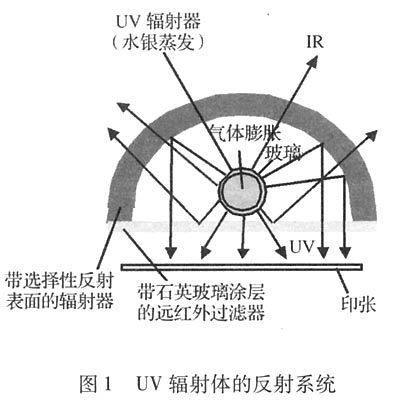A conventional UV drying device operates with one or several mercury vapor lamps, as shown in FIG. Its wavelength range is between 100~380nm. The entire wavelength range can be divided into 3 working zones: 100 to 280 nm for the C zone, which is the most basic part for the rapid and complete reaction of the polymerization of printing inks and bright oils; the zone above 280 nm to 315 nm is due to its wavelength Long, it supports and maintains a “lagging†reaction, giving it a good drying effect; A is a zone above 315 nm to 380 nm, which guarantees a very thick layer of ink and dry coating. This device is covered by a mirror cover. The best, ordered, and generated ozone extraction is an integral part of the entire installation. When designing the drying device, it is necessary to consider that the ozone content in the air must not exceed the allowable critical limit of 0.1 ppm, and to avoid damage to human health, such as irritation to the mucous membrane of the eye.

Another form of UV drying is a monochromatic light-excited radiation device. It is a special UV lamp device that uses monochromatic light (almost all with 308nm wavelength), as shown in Figure 2. The advantages of this radiation device are: 1) Since the radiator does not require any far-infrared rays, the paper is not heated; 2) No ozone is generated at a wavelength of 308 nm; 3) The induction drying process makes good use of the inductance temperature.

The disadvantage is that the current energy of the excitation radiation device is up to 50W/cm, which is still lower than the energy of the mercury lamp (more than 250W/cm). If radiation occurs in an inert gas (such as nitrogen) environment, it will still produce the desired drying effect; the photosensitizer system of the ink needs to be adjusted to this particular wavelength. Conventional UV lamps are multicolored and therefore cover a wide range of light-sensitive material lightwaves.
Excitation drying devices are particularly suitable for applications on substrates with heat-sensitive substances such as metal foils, such as flexo printing drying.
UV drying strengths: UV ink completely dry by radiation; does not interfere with the ink on the ink penetration and adhesion; can be followed by post-press processing (such as: cutting, indentation, embossing, punching, etc.); can be no absorption Printing on the substrate (metal, foil).
Inadequacies: Due to the need for additional equipment, leading to higher investment; printing ink and cleaning agent costs higher; UV lamp life is shorter; not suitable for absorbent substrates; UV offset ink ash / fly The ink phenomenon limits the printing speed (due to the rheological properties of the ink, such as stickiness).
3 Electron Beam Drying (EBC)
Electron beam drying also uses special inks. Reactive polymers (such as unsaturated polyesters and unsaturated acrylic polymers) and polyfunctional monomers in the inks rapidly polymerize after electron beam irradiation and allow the prints to dry instantly. Electron beam drying is a type of high-energy ionizing radiation that ionizes the molecules in a printing ink vehicle, resulting in the release of radicals (free radicals). Today, electron beam drying is used for special prints, such as food packaging, because the ink is completely dry and can completely kill microorganisms in the substrate. However, its drying system and ink are relatively expensive.
In theory, electron beam drying (EBC) can be used with the same binder ink, and UV drying can also be used. Due to the high energy, a sufficient number of excited molecular groups are released in the binder, so there is no need to add expensive photosensitizers. The advantage of this is that the ink has better storage stability. However, radiation must be carried out in an inert gas atmosphere because the presence of oxygen not only strongly hinders curing, but also causes oxidative aging of the ink layer due to radiation and may cause oxidative degradation of the substrate. Without the use of oxygen, the amount of radiation required to dry the ink layer will only cause minor damage. Drying with electron beam, the substrate or ink layer will not appear undesirably high heat. Figure 3 shows the arrangement of the components of the radiation device. Electrically heated tungsten filaments can be used as electron beam drying sources for webs.

The advantages of electron beam curing (EBC) drying: rapid drying; the temperature of irradiated prints does not increase; printing on both sides (both sides printing) is simultaneous drying. When printing on both sides, it is only necessary to radiate from one side of the substrate (except for tin and metal foil printing).
Disadvantages are: high equipment investment costs, and expensive ink; must have X-ray protection devices; radiation needs to be carried out in a protective atmosphere (such as nitrogen); if radiation is too high, the substrate may be damaged; High printing ink costs.
4 Conclusion
In addition to physical drying and chemical drying, other auxiliary drying techniques need to be attached to the printing. For example, after the ink is transferred to the printing area, the infiltration process starts. At this time, the ink layer adhered to the substrate has a high viscosity, and its hardening effect is often insufficient to avoid stickiness. If no measures are taken, in many cases the printed sheets on the delivery table will stick together. The method of powder spraying in sheet-fed printing and the method of applying silicone oil in web offset printing are commonly used techniques to avoid sticking and ensure normal drying of the ink. (Text / Cheng Chang Shi Xiangdong)